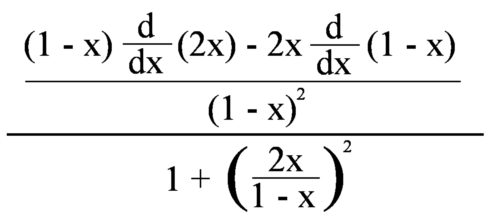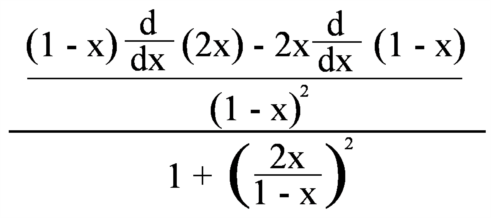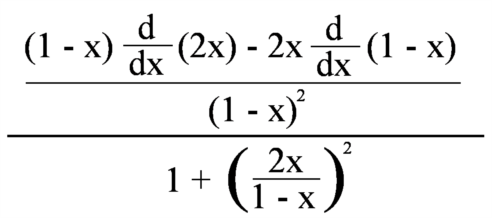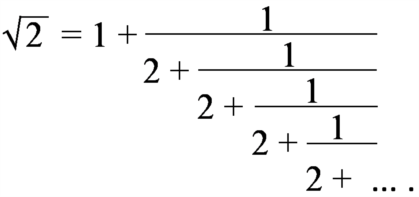Nemeth Code Rules
RULE XII--FRACTIONS
Fraction Indicators- Simple
- Opening?
- Closing#
- Complex
- Opening,?
- Closing,#
- Hypercomplex
- Opening,,?
- Closing,,#
- Fractional Part of a Mixed Number
- Opening_?
- Closing_#
- Used with Simple-Fraction Indicators
- Diagonal line or slash_/
- Horizontal/
- Used with the Fractional Part of a Mixed Number
- Diagonal line or slash_/
- Horizontal/
- Used with Complex-Fraction Indicators
- Diagonal line or slash,_/
- Horizontal,/
- Used with Hypercomplex-Fraction Indicators
- Horizontal,,/
- Used with a Spatial Arrangement
- Horizontal (varying in length)33333
§61. Simple Fractions: For the purposes of this Code, a simple Fraction is one whose numerator and denominator contain no Fractions except possibly at the superscript or subscript level.
§62. Use of Simple-Fraction Indicators:
a. Simple-Fraction indicators must be used, except in the case of mixed numbers, to enclose a simple Fraction whose numerator and denominator are separated by a horizontal Fraction line in ink print.
b. Simple-Fraction indicators must be used to enclose a simple Fraction whose numerator and denominator are separated by a diagonal line in ink print, when the expressions on either side of the diagonal line appear at different levels relative to it, or in different type size than is normal for the purpose for which these expressions are used.


§63. Non-Use of Simple-Fraction Indicators:
a. Simple-Fraction indicators must not be used to enclose the Fractional part of a mixed number.
b. Simple-Fraction indicators must not be used to enclose a simple Fraction whose numerator and denominator are separated by a diagonal line in ink print when the expressions on either side of the diagonal line appear at the same level relative to it, or are of the
same type size as the surrounding Mathematical text. Sometimes the expressions on either side of the diagonal line are not the terms of a Fraction at all. Even when they are, the transcriber cannot always be certain of where the Fraction begins or ends. Accordingly, it is better to avoid the use of indicators altogether in these cases and permit the braille reader to make a judgment based on the same information that is available to the sighted reader.





|
verbose semantics |
left-parenthesis a plus b right-parenthesis slash left-parenthesis c plus d right-parenthesis |

|
§64. Mixed Numbers: For the purposes of this Code, a mixed number is an expression which begins with a numeral and is followed, usually in smaller type, by a simple Fraction whose numerator and denominator are both numerals. The Fraction line of this simple Fraction may be either horizontal or diagonal in ink print. The mixed-number indicators must be used to enclose the Fractional part of a mixed number. An expression is not a mixed number if it contains any letter, even though such an expression is of the same form as a mixed number in every other respect.
§65. Complex Fractions: For the purposes of this Code, a complex Fraction is one whose numerator, denominator, or both, contains at least one simple Fraction. A Fraction is not a complex Fraction if the only simple Fractions it contains are at the superscript or subscript level.
§66. Use of Complex-Fraction Indicators: Complex-Fraction indicators must be used to enclose a complex Fraction.
§67. Hypercomplex Fractions: For the purposes of this Code, a hypercomplex Fraction is one whose numerator, denominator, or both, contains at least one complex Fraction. A Fraction is not a hypercomplex Fraction if the only complex Fractions it contains are at the superscript or subscript level.

|
verbose semantics |
StartFraction
a Over
b Superscript
StartFraction
three-fourths Over
five-sixths EndFraction
Baseline
EndFraction
|

|
§68. Use of Hypercomplex-Fraction Indicators:
a. Hypercomplex-Fraction indicators must be used to enclose a hypercomplex Fraction. The use of a linear arrangement within a spatial arrangement is preferable to an arrangement which is entirely linear or entirely spatial.

,,?3333333333333333333333,,#
#5
|
verbose semantics |
StartStartFraction
StartFraction
1 and one-fourth Over
1 and three-fifths EndFraction
OverOver
5 EndEndFraction
|

|

-#2x?d/dx#(1-x)
,/(1-x)^2",#
,,?333333333333333333,,#
#1+(?2x/1-x#)^2

(1-x)?33#(2x)-2x?33#(1-x)
;x ;x
,?3333333333333333333333333,#
(1-x)^2
,,?33333333333333333333333333333,,#
#2x
#1+(?3333#)^2
#1-x

,/(1-x)^2",#,,/1+(?2x/1-x#)^2",,#
b. Hypercomplex Fractions of higher order may be transcribed in the manner suggested by a above. It is only necessary to use dot 6 the proper number of times before the Fraction indicators and their matching Fraction line.
§69. Continued Fractions: A continued Fraction is one in which each denominator, except possibly the last one, is the sum of a whole number and a Fraction. A spatial arrangement must be used for each Fraction. In this case, each Fraction line must have proportionately the length shown in print, and Fraction indicators of any kind must not be used with a continued Fraction.

>2] .k #1+333333333333
#1
#2+333333333
#1
#2+333333
#1
#2+333
#x+ '''_4
|
verbose semantics |
StartRoot
2 EndRoot
equals 1 plus ContinuedFraction
1 Over
2 plus StartFraction
1 Over
2 plus StartFraction
1 Over
2 plus StartFraction
1 Over
2 plus ellipsis |

|
§70. Spatial Arrangement for Fractions:
a. Whenever a Fraction is transcribed spatially, all Fraction indicators, except for continued Fractions, must be shown, and each Fraction line must have precisely the length necessary to cOver the longest expression to which it applies, and the terms of the Fraction
must be centered on their Fraction lines. The runOver of an expression which is too long to be centered on the Fraction line which applies to it may be effected at suitable places in accordance with the rules for runOvers, but each portion of the divided expression must be centered on the Fraction line to which the expression, as a whole, applies.
b. In general, the linear arrangement for Fractions must be used when no expressly forbidden in the case of continued Fractions. However, when Fractional notation is first presented to the reader, as in the lower grades, or when there is any other special need, any Fraction may be represented spatially.

?33333333#?333333#?333333#?3333333#
#1 mi #1 hr #60 m9 #60 sec
#88 ft
.k ?333333# .k #88 ft_/sec4
#1 sec
c. For spatial arrangement of Fractions in connection with cancellation see §60.
d. For spatial arrangement of hypercomplex Fractions see §68.
e. For spatial arrangements of continued Fractions see §69.































